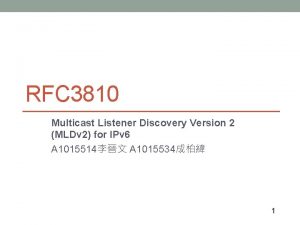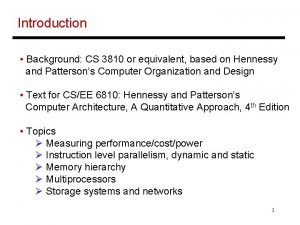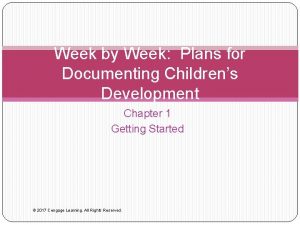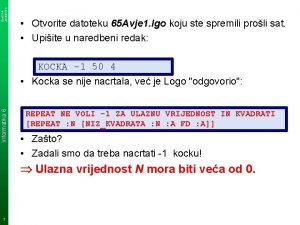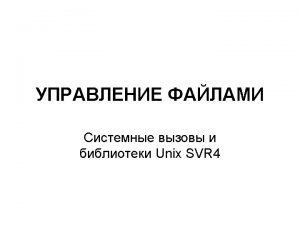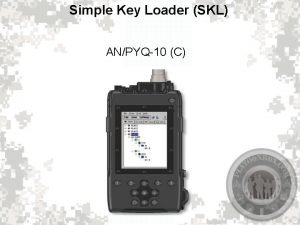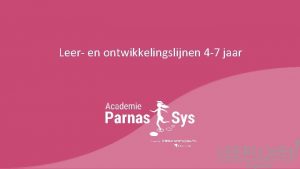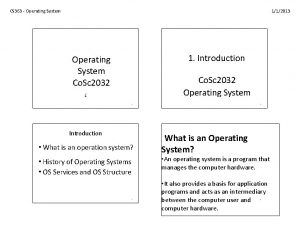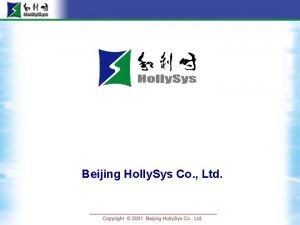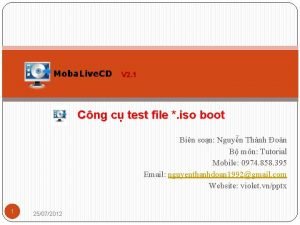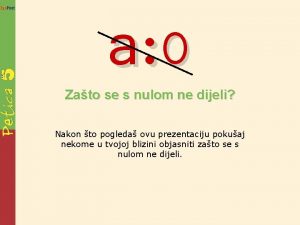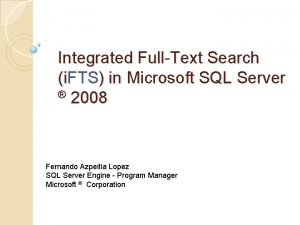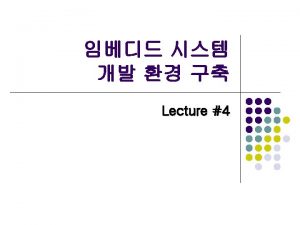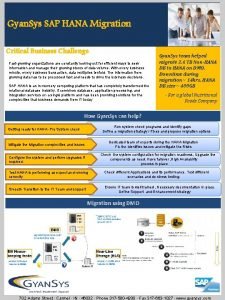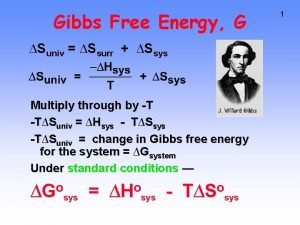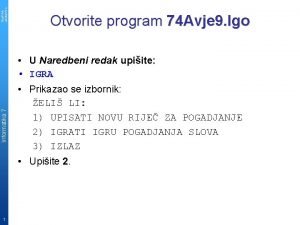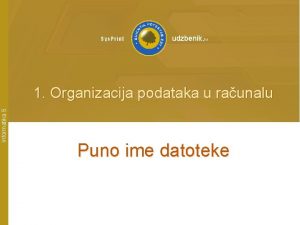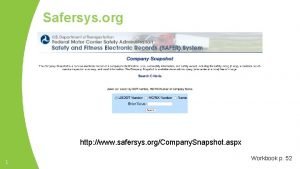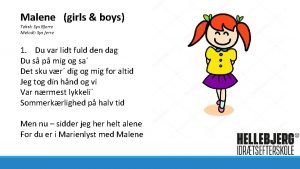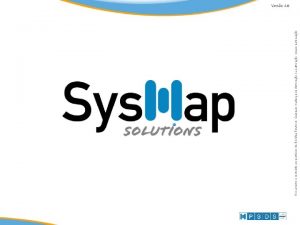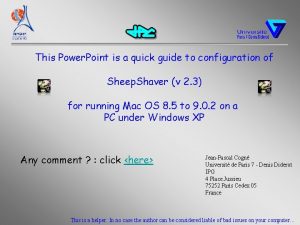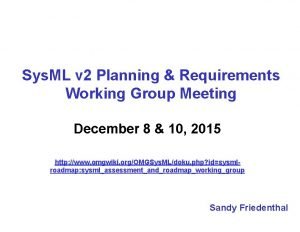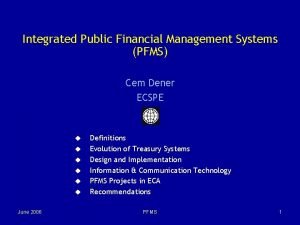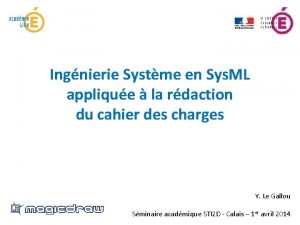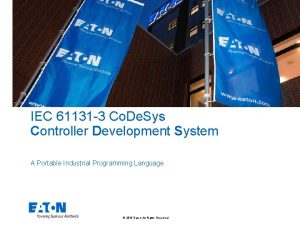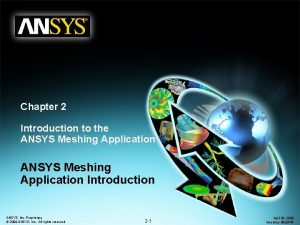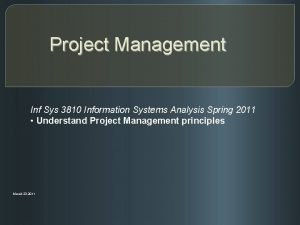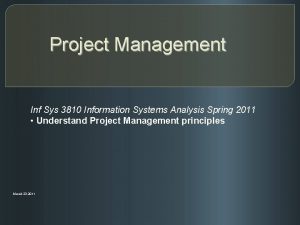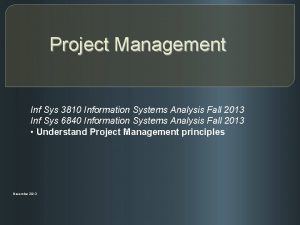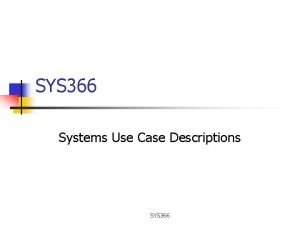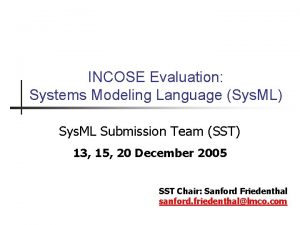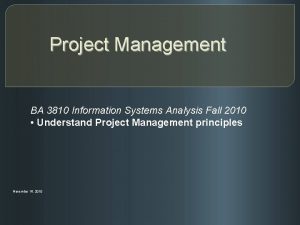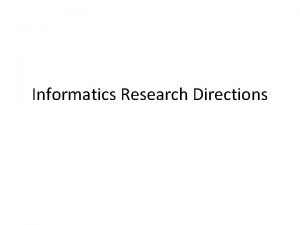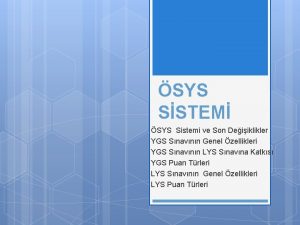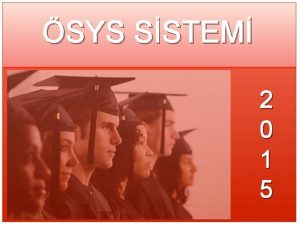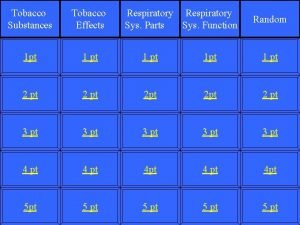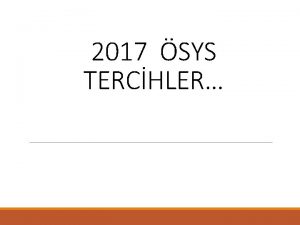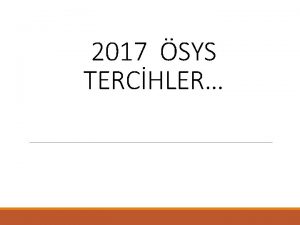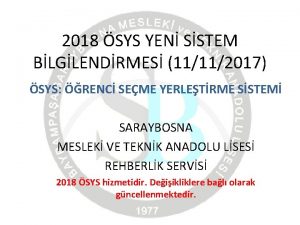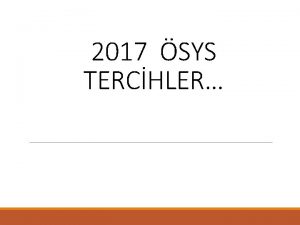Info Sys 3810 Week Three 2013 Systems Analysis









































- Slides: 41

Info. Sys 3810 Week Three 2013 Systems Analysis Dr. Vicki Sauter and Friends Professor, Information Systems University of Missouri Saint Louis

Last Week Systems Analysis and Design Five fundamental, separable, yet interrelated elements Ø Planning … including requirements elicitation Ø Analysis Ø Design (including logical design and physical design ( or preliminary design and detailed design) Ø Implementation … which includes coding, test, and deployment Ø And Ø Maintenance

Last Week Systems Analysis and Design The waterfall model … a sequential process where one phase is completed before the next is started … ØThere is significant formalism to this model ØThere is little actual use of this model in today’s Information Systems world The Waterfall model is just one systems development methodology

Last Week Systems Analysis … A Definition Systems Analysis is an explicit formal inquiry carried out to help someone identify a better course of action and make a better decision than he might otherwise have made. Øidentification and re-identification) of objectives, constraints, and alternative courses of action Øof the probable consequences of the alternatives in terms of costs, benefits, and risks Øpresentation of the results in a comparative framework so that the decision maker can make an informed choice from among the alternatives © Principia Cybernetica Web

Last Week Systems and Systems Analysis Definition of a System A system is composed of interacting parts that operate together to achieve some objective or purpose. a system is intended to "absorb" inputs, process them in some way and produce outputs (where outputs are defined by goals, objectives or common purposes)

Last Week

Last Week

Last Week Different perspectives … for different needs 8 / 49

Last Week Zachman Framework, Cont © R. A. Navarro

Last Week Business Rules A business rule is a rule of a business, company, or corporation. It is a rule that defines or constrains some aspect of business and always resolves to either true or false. Business rules are intended to assert business structure or to control or influence the behavior of the business. Business rules describe the operations, definitions and constraints that apply to an organization. Business rules can apply to people, processes, corporate behavior and computing systems in an organization, and are put in place to help the organization achieve its goals. Wikipedia. net

The Requirements Phase of Process Development Definition ( Wikipedia) ØA requirement is a documented need of what a particular system should be or do. ØA requirement can be a description of what a system must do. This type of requirement specifies something that the delivered system must be able to do. ØOther types of requirements specify something about the system itself, and how well it performs its functions. © R. A. Navarro 11/42

Formal Requirements Business Processes Design And Development Must Be Based On Formal Requirements ØFunctional requirements ØNon-functional requirements ØPseudo requirements © R. A. Navarro 12/42

Formal Requirements Methodologies for Requirements Elicitation Ø Archival document analysis Ø Document review Ø Inspiration / Imagineering Ø Interviews Ø Surveys or Questionnaires Ø Delphi Method Ø Direct Observation Ø Contextual Inquiry Ø Concept Elicitation Ø Focus Groups Ø RAD / JAD Ø Prototyping © R. A. Navarro Individualoriented methods Grouporiented methods 13/42

Creativity


The Calf Path One day thru the primeval wood A calf walked home, as good calves should, But made a trail all bent askew, A crooked trail, as all calves do. Since then three hundred years have fled, And I infer, the calf is dead; But still behind he left his trail, And thereon hangs my mortal tale. The trail was taken up next day By a lone dog that passed that way, And then a wise bell-weather sheep Sliding into a rut now deep, Pursued that trail over hill and glade Thru those old woods a path was made.

The Calf Path And many men wound in and out, And dodged and turned and bent about, and uttered words of righteous wrath Because “twas such a crooked path” But still they follow-do not laugh. The first migrations of that calf. The forest became a lane That bent and turned again; This crooked lane became a road where many a poor horse with his load Toiled on beneath the burning sun, And traveled some three miles in one.

The Calf Path The years passed on in swiftness fleet, The village road became a street, And this, before the men were aware, A city’s crowded thoroughfare. And soon a central street was this In a renowned metropolis; And men two centuries and a half Followed the wanderings of this calf. Each day a hundred thousand strong Followed this zigzag calf along; And over his crooked journey went The traffic of a continent.

The Calf Path A hundred thousand men were led By one poor calf, three centuries dead. For just such reverence is lent To well established precedent. A moral lesson this might teach Were I ordained and called to preach. For men are prone to go it blind Along the calf paths of the mind; And work away from sun to sun To do what other men have done. Sam Walter Foss











Class Discussion

Class Exercise Re: The UMSL Library System Ø You have all researched the UMSL Library Business Rules Ø You all understand the function of a library from a student’s point of view Ø Develop an Improved set of business rules Be Creative

Notes Networking Expectations are defined on the class website ØThere is a networking opportunity tomorrow morning … ØBreakfast and Business Ø 7: 30 am in the MSC ØFeaturing Juli Niemann … “What Recovery”

Systems analysis There are two fundamentally different ways of approaching systems analysis ØProcess View ØData View

Systems Analysis … Processes vs Data Points of View

Systems Analysis … The Process View A Process is defined as ØA sequence of related tasks which combine to accomplish a function ØA transformation

Systems Analysis … The Process View A system may be “modeled” using a process documentation formalism ØA language ØA representation Schema Typical among such schema ØVisio ØIBM Flow-Charting Templates ØIDEF

Systems Analysis … Data View Data are values of qualitative or quantitative variables ØData in are typically represented in a structure, often tabular, a tree, or a graph structure. ØData are typically the results of measurements ØData as an abstract concept can be viewed as the lowest level of abstraction from which information and then knowledge are derived

Systems Analysis … Data View Wisdom Knowledge Information Data

Systems Analysis … Data View

Systems Analysis … Data View DFD’s show ØInput to and output from the system across the system boundary ØInputs and outputs to and from system elements ØFlow among systems elements ØStorages DFD’s do NOT show timing, control etc.

Class Exercise Working in groups: Define the data necessary to support a system developed to meet YOUR new library business rules
 Mldv
Mldv Cs 3810
Cs 3810 Week by week plans for documenting children's development
Week by week plans for documenting children's development Embedded systems week
Embedded systems week Unix c sys wipro
Unix c sys wipro Informatika
Informatika Sys print informatika 5
Sys print informatika 5 Sys stat h
Sys stat h Sys dm_db_index_physical_stats
Sys dm_db_index_physical_stats Tm 11-5810-410-13&p
Tm 11-5810-410-13&p Bio sys
Bio sys Parnas sys
Parnas sys Parnas sys
Parnas sys Fleksibilitas serea
Fleksibilitas serea Sys.availability_replicas
Sys.availability_replicas Cs 363
Cs 363 Https //docs. python.org/3/library/index.html
Https //docs. python.org/3/library/index.html Holly sys
Holly sys Test file iso
Test file iso Potencia monofasica
Potencia monofasica Sys print
Sys print Sys.indexes
Sys.indexes Azure data warehouse
Azure data warehouse Dm_fts_parser
Dm_fts_parser Pentium iv
Pentium iv Xxx video hidi
Xxx video hidi Gyan sys
Gyan sys Ssurr
Ssurr Sys print informatika
Sys print informatika Sys informatika
Sys informatika Www.safersys
Www.safersys Min lejlighed er lidt brændt ned
Min lejlighed er lidt brændt ned /sys/class/gpio/export
/sys/class/gpio/export Sys map
Sys map I coder
I coder Uide.sys
Uide.sys Sheepshaver tutorial
Sheepshaver tutorial Sys ml
Sys ml Rec mgm sys
Rec mgm sys Besoin initial
Besoin initial Iec 61131-3
Iec 61131-3 Ansys meshing manual
Ansys meshing manual
